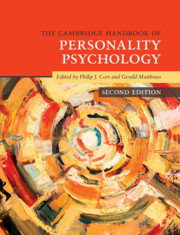Book contents
- The Cambridge Handbook of Personality Psychology
- Cambridge Handbooks in Psychology
- The Cambridge Handbook of Personality Psychology
- Copyright page
- Contents
- Figures
- Tables
- Contributors
- Preface
- General Introduction
- Part I Foundational Issues: History and Approaches to Personality
- Part II Description and Measurement: How Personality Is Studied
- Part III Development, Health and Change: Life Span and Health Outcomes
- Part IV Biological Perspectives: Evolution, Genetics and Neuroscience of Personality
- Part V Cognitive and Motivational Perspectives: Dynamic Processes of Personality
- 21 Cognitive Processes and Models
- 22 Self-Regulation and Control in Personality Functioning
- 23 Basic Needs, Goals and Motivation
- 24 Personality and the Self
- 25 Traits and Dynamic Processes
- 26 Anxiety, Depression and Cognitive Dysfunction
- Part VI Social and Cultural Processes: Personality at the Intersection of Society
- Part VII Applications of Personality Psychology: Personality Traits and Processes in Action
- Addendum: Statistical Analyses and Computer Programming in Personality
- Index
- References
24 - Personality and the Self
from Part V - Cognitive and Motivational Perspectives: Dynamic Processes of Personality
Published online by Cambridge University Press: 18 September 2020
- The Cambridge Handbook of Personality Psychology
- Cambridge Handbooks in Psychology
- The Cambridge Handbook of Personality Psychology
- Copyright page
- Contents
- Figures
- Tables
- Contributors
- Preface
- General Introduction
- Part I Foundational Issues: History and Approaches to Personality
- Part II Description and Measurement: How Personality Is Studied
- Part III Development, Health and Change: Life Span and Health Outcomes
- Part IV Biological Perspectives: Evolution, Genetics and Neuroscience of Personality
- Part V Cognitive and Motivational Perspectives: Dynamic Processes of Personality
- 21 Cognitive Processes and Models
- 22 Self-Regulation and Control in Personality Functioning
- 23 Basic Needs, Goals and Motivation
- 24 Personality and the Self
- 25 Traits and Dynamic Processes
- 26 Anxiety, Depression and Cognitive Dysfunction
- Part VI Social and Cultural Processes: Personality at the Intersection of Society
- Part VII Applications of Personality Psychology: Personality Traits and Processes in Action
- Addendum: Statistical Analyses and Computer Programming in Personality
- Index
- References
Summary
In his influential text, William James (1890) devoted separate chapters to the self and to its habits. His chapter on the self focused on the malleability of self-views and the manner in which they are diverse, encompassing disparate aspects such as the material, social and spiritual selves. By contrast, his chapter on habits highlighted the ways in which an individual becomes more and more like a particular type of person, with a particular type of disposition, over time. Whether functional or dysfunctional, habits coalescence into personality traits, and these personality traits become relatively fixed by the age of thirty.
- Type
- Chapter
- Information
- The Cambridge Handbook of Personality Psychology , pp. 339 - 351Publisher: Cambridge University PressPrint publication year: 2020
References
- 6
- Cited by

